Report: Cost Benefit Analysis of the ACT Container Deposit Scheme
VerifiedAdded on 2023/04/19
|20
|4733
|437
Report
AI Summary
This assignment presents a comprehensive cost-benefit analysis (CBA) of the ACT Container Deposit Scheme (CDS), examining its economic and environmental impacts. The report begins with an executive summary outlining the scheme's objectives, which include reducing waste, increasing recycling rates, and minimizing litter. It details the project scope, design, costs (including design, administration, and infrastructure), and the historical context of container deposit schemes in Australia. The analysis then reviews ex-ante CBA, identifies issues in ex-post evaluation, and reproduces the ex-ante CBA with revised costs and benefits. Project forecasts are presented, alongside the application of CBA theory and valuation techniques. The report compares ex-ante and ex-post CBA outcomes, analyzes the importance of the CBA report for decision-makers, and concludes with lessons learned and recommendations. Key aspects include the reduction of litter, increased recycling, and the economic benefits associated with the scheme, supported by tables detailing costs, benefits, and forecasted results.
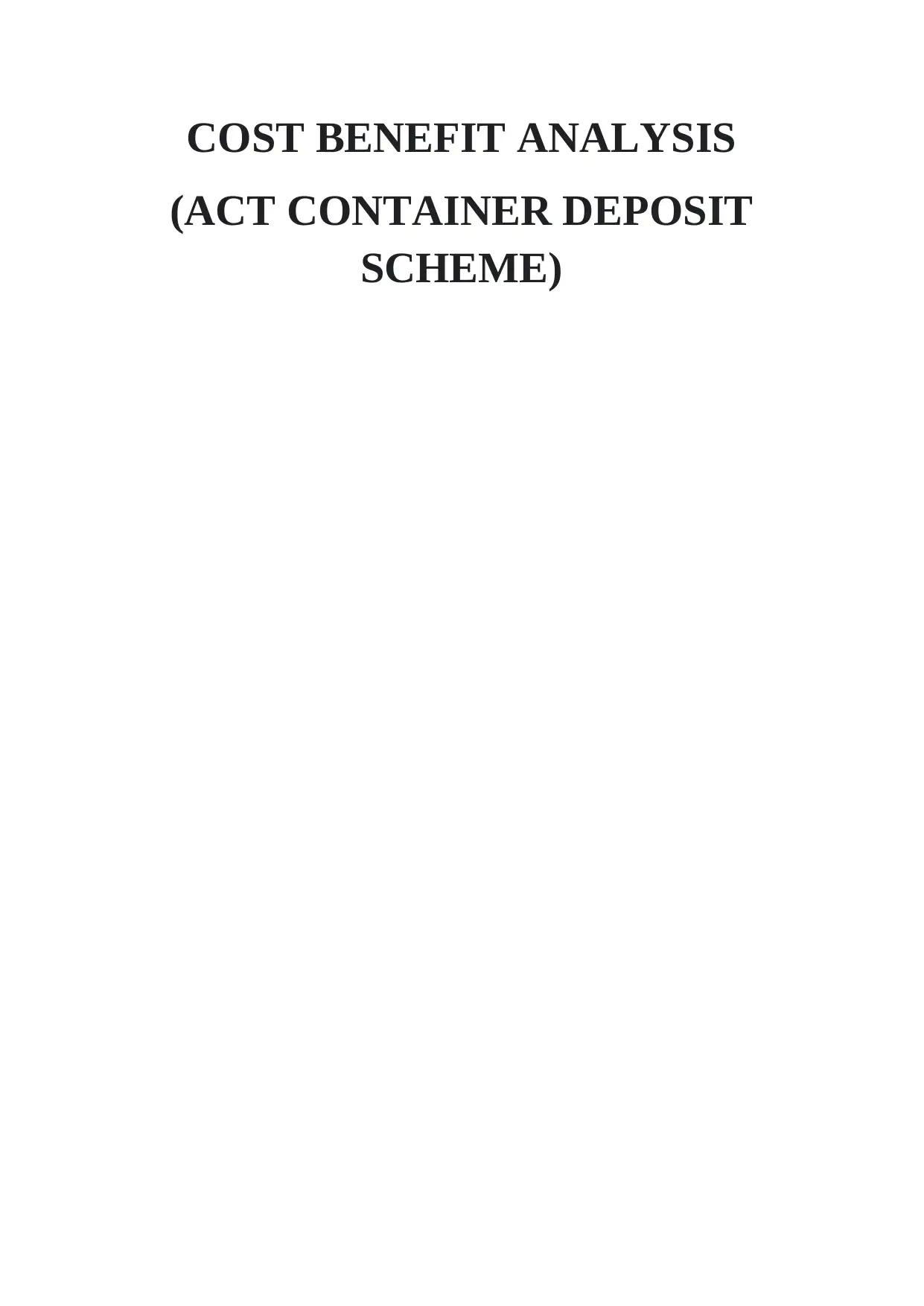
COST BENEFIT ANALYSIS
(ACT CONTAINER DEPOSIT
SCHEME)
(ACT CONTAINER DEPOSIT
SCHEME)
Paraphrase This Document
Need a fresh take? Get an instant paraphrase of this document with our AI Paraphraser
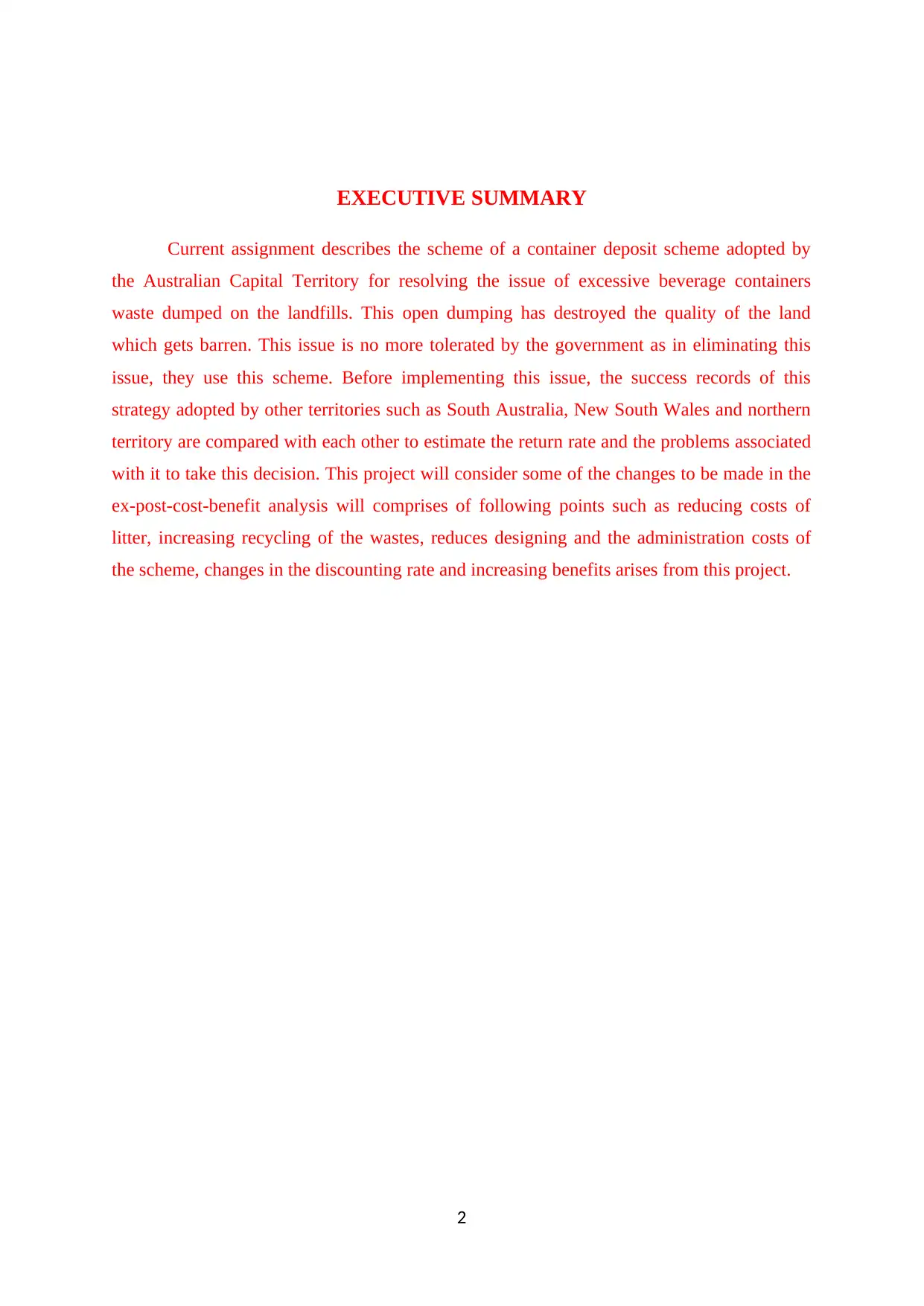
EXECUTIVE SUMMARY
Current assignment describes the scheme of a container deposit scheme adopted by
the Australian Capital Territory for resolving the issue of excessive beverage containers
waste dumped on the landfills. This open dumping has destroyed the quality of the land
which gets barren. This issue is no more tolerated by the government as in eliminating this
issue, they use this scheme. Before implementing this issue, the success records of this
strategy adopted by other territories such as South Australia, New South Wales and northern
territory are compared with each other to estimate the return rate and the problems associated
with it to take this decision. This project will consider some of the changes to be made in the
ex-post-cost-benefit analysis will comprises of following points such as reducing costs of
litter, increasing recycling of the wastes, reduces designing and the administration costs of
the scheme, changes in the discounting rate and increasing benefits arises from this project.
2
Current assignment describes the scheme of a container deposit scheme adopted by
the Australian Capital Territory for resolving the issue of excessive beverage containers
waste dumped on the landfills. This open dumping has destroyed the quality of the land
which gets barren. This issue is no more tolerated by the government as in eliminating this
issue, they use this scheme. Before implementing this issue, the success records of this
strategy adopted by other territories such as South Australia, New South Wales and northern
territory are compared with each other to estimate the return rate and the problems associated
with it to take this decision. This project will consider some of the changes to be made in the
ex-post-cost-benefit analysis will comprises of following points such as reducing costs of
litter, increasing recycling of the wastes, reduces designing and the administration costs of
the scheme, changes in the discounting rate and increasing benefits arises from this project.
2

3
⊘ This is a preview!⊘
Do you want full access?
Subscribe today to unlock all pages.

Trusted by 1+ million students worldwide
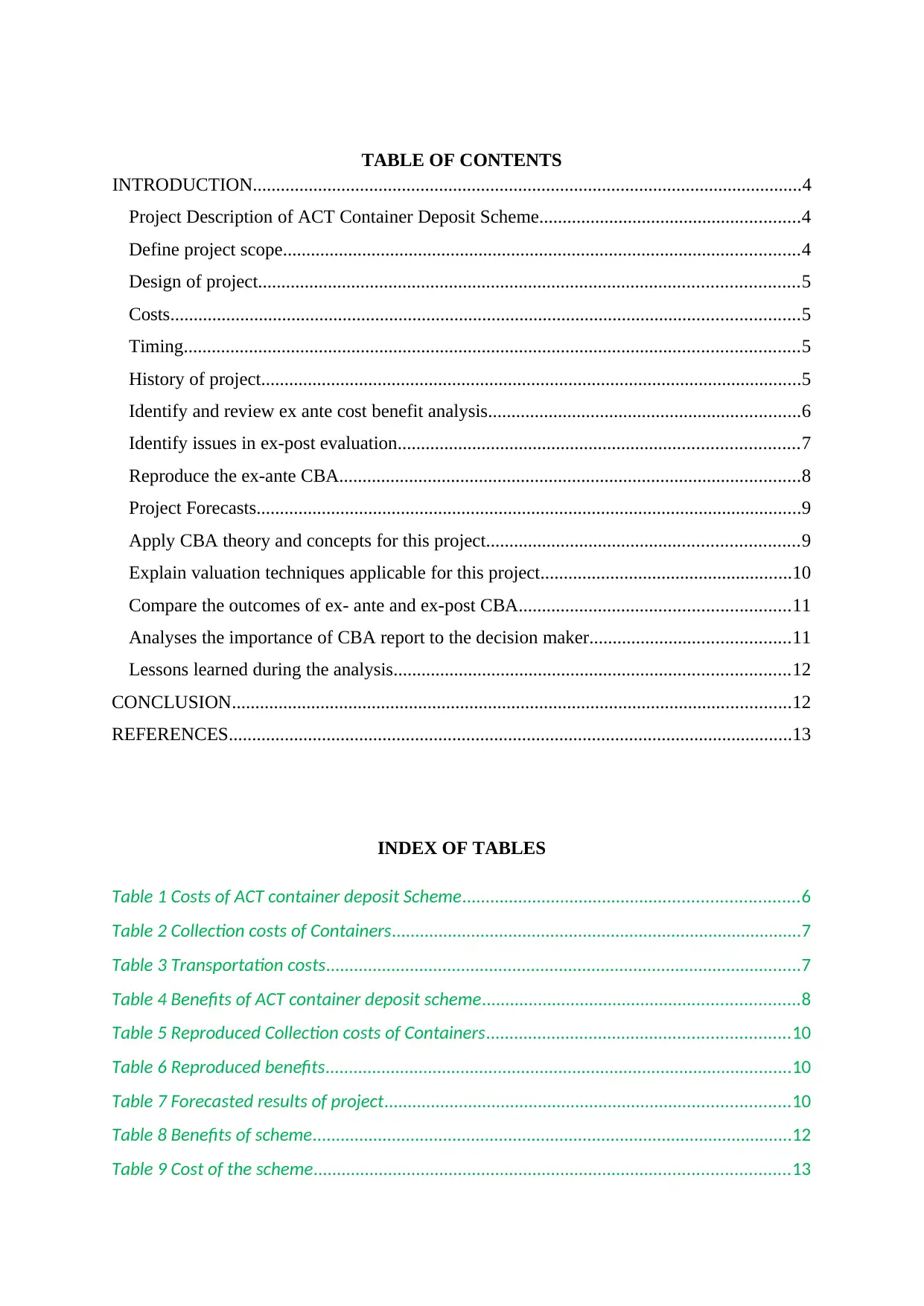
TABLE OF CONTENTS
INTRODUCTION......................................................................................................................4
Project Description of ACT Container Deposit Scheme........................................................4
Define project scope...............................................................................................................4
Design of project....................................................................................................................5
Costs.......................................................................................................................................5
Timing....................................................................................................................................5
History of project....................................................................................................................5
Identify and review ex ante cost benefit analysis...................................................................6
Identify issues in ex-post evaluation......................................................................................7
Reproduce the ex-ante CBA...................................................................................................8
Project Forecasts.....................................................................................................................9
Apply CBA theory and concepts for this project...................................................................9
Explain valuation techniques applicable for this project......................................................10
Compare the outcomes of ex- ante and ex-post CBA..........................................................11
Analyses the importance of CBA report to the decision maker...........................................11
Lessons learned during the analysis.....................................................................................12
CONCLUSION........................................................................................................................12
REFERENCES.........................................................................................................................13
INDEX OF TABLES
Table 1 Costs of ACT container deposit Scheme........................................................................6
Table 2 Collection costs of Containers........................................................................................7
Table 3 Transportation costs......................................................................................................7
Table 4 Benefits of ACT container deposit scheme....................................................................8
Table 5 Reproduced Collection costs of Containers.................................................................10
Table 6 Reproduced benefits....................................................................................................10
Table 7 Forecasted results of project.......................................................................................10
Table 8 Benefits of scheme.......................................................................................................12
Table 9 Cost of the scheme......................................................................................................13
INTRODUCTION......................................................................................................................4
Project Description of ACT Container Deposit Scheme........................................................4
Define project scope...............................................................................................................4
Design of project....................................................................................................................5
Costs.......................................................................................................................................5
Timing....................................................................................................................................5
History of project....................................................................................................................5
Identify and review ex ante cost benefit analysis...................................................................6
Identify issues in ex-post evaluation......................................................................................7
Reproduce the ex-ante CBA...................................................................................................8
Project Forecasts.....................................................................................................................9
Apply CBA theory and concepts for this project...................................................................9
Explain valuation techniques applicable for this project......................................................10
Compare the outcomes of ex- ante and ex-post CBA..........................................................11
Analyses the importance of CBA report to the decision maker...........................................11
Lessons learned during the analysis.....................................................................................12
CONCLUSION........................................................................................................................12
REFERENCES.........................................................................................................................13
INDEX OF TABLES
Table 1 Costs of ACT container deposit Scheme........................................................................6
Table 2 Collection costs of Containers........................................................................................7
Table 3 Transportation costs......................................................................................................7
Table 4 Benefits of ACT container deposit scheme....................................................................8
Table 5 Reproduced Collection costs of Containers.................................................................10
Table 6 Reproduced benefits....................................................................................................10
Table 7 Forecasted results of project.......................................................................................10
Table 8 Benefits of scheme.......................................................................................................12
Table 9 Cost of the scheme......................................................................................................13
Paraphrase This Document
Need a fresh take? Get an instant paraphrase of this document with our AI Paraphraser
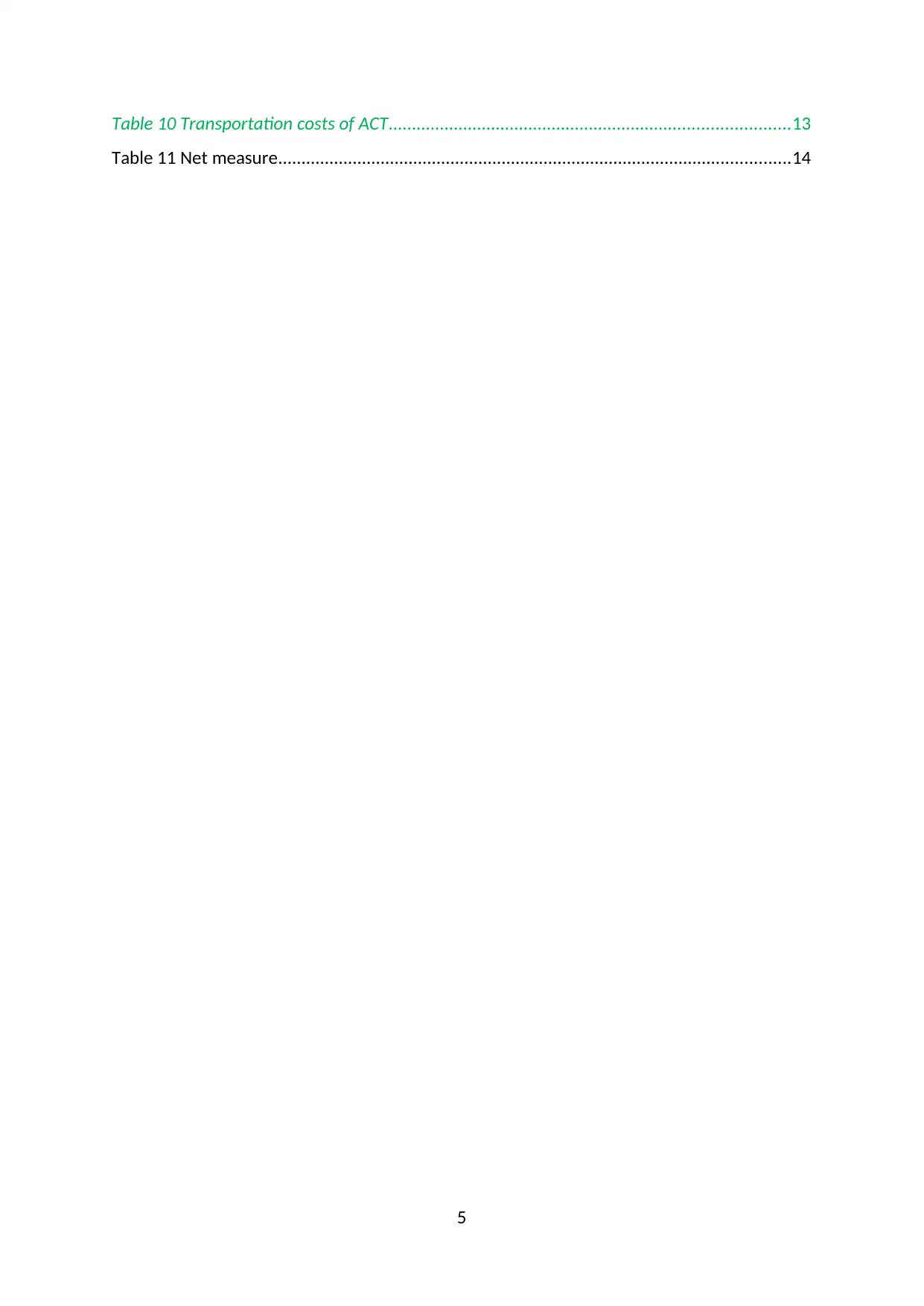
Table 10 Transportation costs of ACT......................................................................................13
Table 11 Net measure..............................................................................................................14
5
Table 11 Net measure..............................................................................................................14
5

6
⊘ This is a preview!⊘
Do you want full access?
Subscribe today to unlock all pages.

Trusted by 1+ million students worldwide
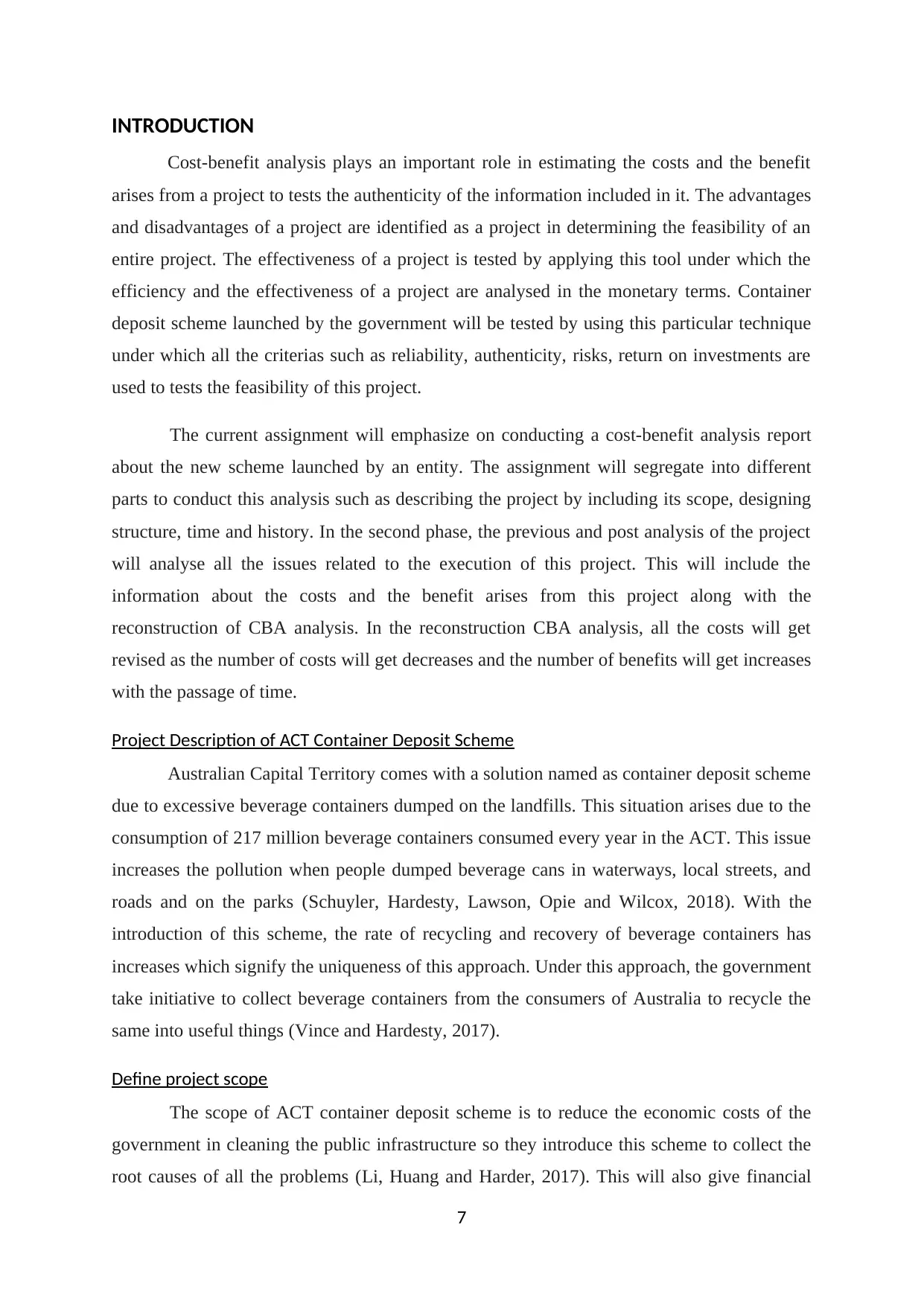
INTRODUCTION
Cost-benefit analysis plays an important role in estimating the costs and the benefit
arises from a project to tests the authenticity of the information included in it. The advantages
and disadvantages of a project are identified as a project in determining the feasibility of an
entire project. The effectiveness of a project is tested by applying this tool under which the
efficiency and the effectiveness of a project are analysed in the monetary terms. Container
deposit scheme launched by the government will be tested by using this particular technique
under which all the criterias such as reliability, authenticity, risks, return on investments are
used to tests the feasibility of this project.
The current assignment will emphasize on conducting a cost-benefit analysis report
about the new scheme launched by an entity. The assignment will segregate into different
parts to conduct this analysis such as describing the project by including its scope, designing
structure, time and history. In the second phase, the previous and post analysis of the project
will analyse all the issues related to the execution of this project. This will include the
information about the costs and the benefit arises from this project along with the
reconstruction of CBA analysis. In the reconstruction CBA analysis, all the costs will get
revised as the number of costs will get decreases and the number of benefits will get increases
with the passage of time.
Project Description of ACT Container Deposit Scheme
Australian Capital Territory comes with a solution named as container deposit scheme
due to excessive beverage containers dumped on the landfills. This situation arises due to the
consumption of 217 million beverage containers consumed every year in the ACT. This issue
increases the pollution when people dumped beverage cans in waterways, local streets, and
roads and on the parks (Schuyler, Hardesty, Lawson, Opie and Wilcox, 2018). With the
introduction of this scheme, the rate of recycling and recovery of beverage containers has
increases which signify the uniqueness of this approach. Under this approach, the government
take initiative to collect beverage containers from the consumers of Australia to recycle the
same into useful things (Vince and Hardesty, 2017).
Define project scope
The scope of ACT container deposit scheme is to reduce the economic costs of the
government in cleaning the public infrastructure so they introduce this scheme to collect the
root causes of all the problems (Li, Huang and Harder, 2017). This will also give financial
7
Cost-benefit analysis plays an important role in estimating the costs and the benefit
arises from a project to tests the authenticity of the information included in it. The advantages
and disadvantages of a project are identified as a project in determining the feasibility of an
entire project. The effectiveness of a project is tested by applying this tool under which the
efficiency and the effectiveness of a project are analysed in the monetary terms. Container
deposit scheme launched by the government will be tested by using this particular technique
under which all the criterias such as reliability, authenticity, risks, return on investments are
used to tests the feasibility of this project.
The current assignment will emphasize on conducting a cost-benefit analysis report
about the new scheme launched by an entity. The assignment will segregate into different
parts to conduct this analysis such as describing the project by including its scope, designing
structure, time and history. In the second phase, the previous and post analysis of the project
will analyse all the issues related to the execution of this project. This will include the
information about the costs and the benefit arises from this project along with the
reconstruction of CBA analysis. In the reconstruction CBA analysis, all the costs will get
revised as the number of costs will get decreases and the number of benefits will get increases
with the passage of time.
Project Description of ACT Container Deposit Scheme
Australian Capital Territory comes with a solution named as container deposit scheme
due to excessive beverage containers dumped on the landfills. This situation arises due to the
consumption of 217 million beverage containers consumed every year in the ACT. This issue
increases the pollution when people dumped beverage cans in waterways, local streets, and
roads and on the parks (Schuyler, Hardesty, Lawson, Opie and Wilcox, 2018). With the
introduction of this scheme, the rate of recycling and recovery of beverage containers has
increases which signify the uniqueness of this approach. Under this approach, the government
take initiative to collect beverage containers from the consumers of Australia to recycle the
same into useful things (Vince and Hardesty, 2017).
Define project scope
The scope of ACT container deposit scheme is to reduce the economic costs of the
government in cleaning the public infrastructure so they introduce this scheme to collect the
root causes of all the problems (Li, Huang and Harder, 2017). This will also give financial
7
Paraphrase This Document
Need a fresh take? Get an instant paraphrase of this document with our AI Paraphraser
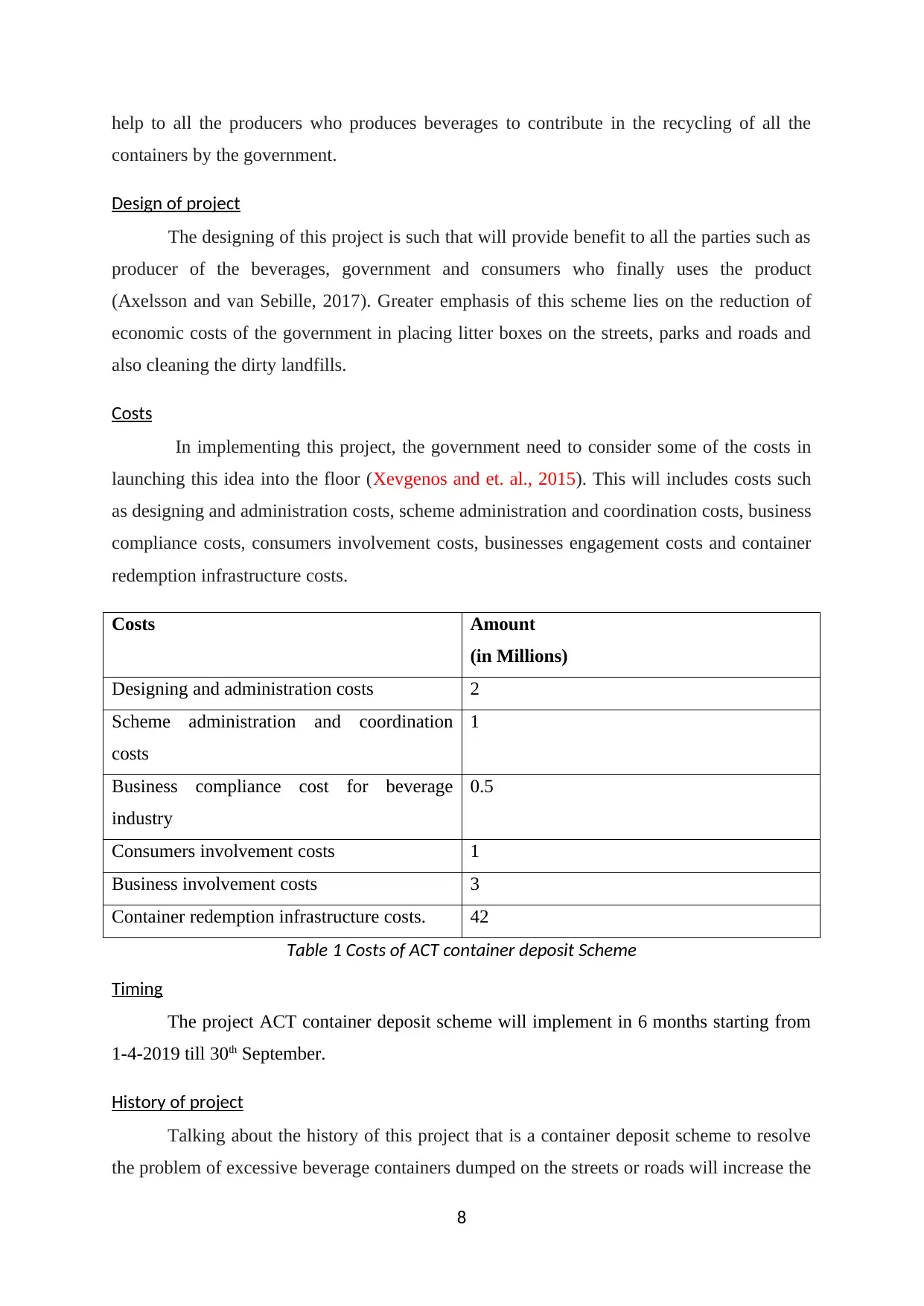
help to all the producers who produces beverages to contribute in the recycling of all the
containers by the government.
Design of project
The designing of this project is such that will provide benefit to all the parties such as
producer of the beverages, government and consumers who finally uses the product
(Axelsson and van Sebille, 2017). Greater emphasis of this scheme lies on the reduction of
economic costs of the government in placing litter boxes on the streets, parks and roads and
also cleaning the dirty landfills.
Costs
In implementing this project, the government need to consider some of the costs in
launching this idea into the floor (Xevgenos and et. al., 2015). This will includes costs such
as designing and administration costs, scheme administration and coordination costs, business
compliance costs, consumers involvement costs, businesses engagement costs and container
redemption infrastructure costs.
Costs Amount
(in Millions)
Designing and administration costs 2
Scheme administration and coordination
costs
1
Business compliance cost for beverage
industry
0.5
Consumers involvement costs 1
Business involvement costs 3
Container redemption infrastructure costs. 42
Table 1 Costs of ACT container deposit Scheme
Timing
The project ACT container deposit scheme will implement in 6 months starting from
1-4-2019 till 30th September.
History of project
Talking about the history of this project that is a container deposit scheme to resolve
the problem of excessive beverage containers dumped on the streets or roads will increase the
8
containers by the government.
Design of project
The designing of this project is such that will provide benefit to all the parties such as
producer of the beverages, government and consumers who finally uses the product
(Axelsson and van Sebille, 2017). Greater emphasis of this scheme lies on the reduction of
economic costs of the government in placing litter boxes on the streets, parks and roads and
also cleaning the dirty landfills.
Costs
In implementing this project, the government need to consider some of the costs in
launching this idea into the floor (Xevgenos and et. al., 2015). This will includes costs such
as designing and administration costs, scheme administration and coordination costs, business
compliance costs, consumers involvement costs, businesses engagement costs and container
redemption infrastructure costs.
Costs Amount
(in Millions)
Designing and administration costs 2
Scheme administration and coordination
costs
1
Business compliance cost for beverage
industry
0.5
Consumers involvement costs 1
Business involvement costs 3
Container redemption infrastructure costs. 42
Table 1 Costs of ACT container deposit Scheme
Timing
The project ACT container deposit scheme will implement in 6 months starting from
1-4-2019 till 30th September.
History of project
Talking about the history of this project that is a container deposit scheme to resolve
the problem of excessive beverage containers dumped on the streets or roads will increase the
8
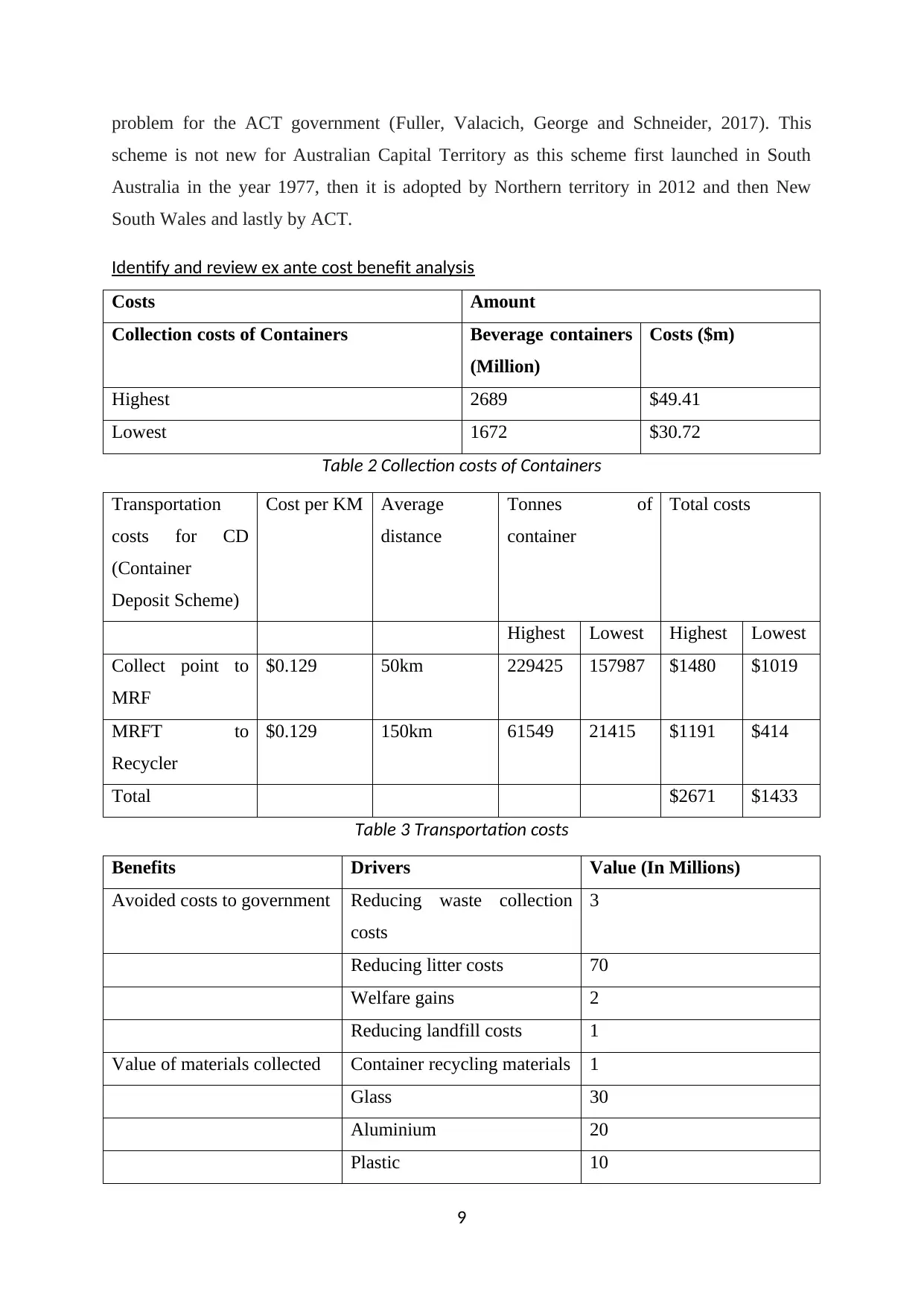
problem for the ACT government (Fuller, Valacich, George and Schneider, 2017). This
scheme is not new for Australian Capital Territory as this scheme first launched in South
Australia in the year 1977, then it is adopted by Northern territory in 2012 and then New
South Wales and lastly by ACT.
Identify and review ex ante cost benefit analysis
Costs Amount
Collection costs of Containers Beverage containers
(Million)
Costs ($m)
Highest 2689 $49.41
Lowest 1672 $30.72
Table 2 Collection costs of Containers
Transportation
costs for CD
(Container
Deposit Scheme)
Cost per KM Average
distance
Tonnes of
container
Total costs
Highest Lowest Highest Lowest
Collect point to
MRF
$0.129 50km 229425 157987 $1480 $1019
MRFT to
Recycler
$0.129 150km 61549 21415 $1191 $414
Total $2671 $1433
Table 3 Transportation costs
Benefits Drivers Value (In Millions)
Avoided costs to government Reducing waste collection
costs
3
Reducing litter costs 70
Welfare gains 2
Reducing landfill costs 1
Value of materials collected Container recycling materials 1
Glass 30
Aluminium 20
Plastic 10
9
scheme is not new for Australian Capital Territory as this scheme first launched in South
Australia in the year 1977, then it is adopted by Northern territory in 2012 and then New
South Wales and lastly by ACT.
Identify and review ex ante cost benefit analysis
Costs Amount
Collection costs of Containers Beverage containers
(Million)
Costs ($m)
Highest 2689 $49.41
Lowest 1672 $30.72
Table 2 Collection costs of Containers
Transportation
costs for CD
(Container
Deposit Scheme)
Cost per KM Average
distance
Tonnes of
container
Total costs
Highest Lowest Highest Lowest
Collect point to
MRF
$0.129 50km 229425 157987 $1480 $1019
MRFT to
Recycler
$0.129 150km 61549 21415 $1191 $414
Total $2671 $1433
Table 3 Transportation costs
Benefits Drivers Value (In Millions)
Avoided costs to government Reducing waste collection
costs
3
Reducing litter costs 70
Welfare gains 2
Reducing landfill costs 1
Value of materials collected Container recycling materials 1
Glass 30
Aluminium 20
Plastic 10
9
⊘ This is a preview!⊘
Do you want full access?
Subscribe today to unlock all pages.

Trusted by 1+ million students worldwide
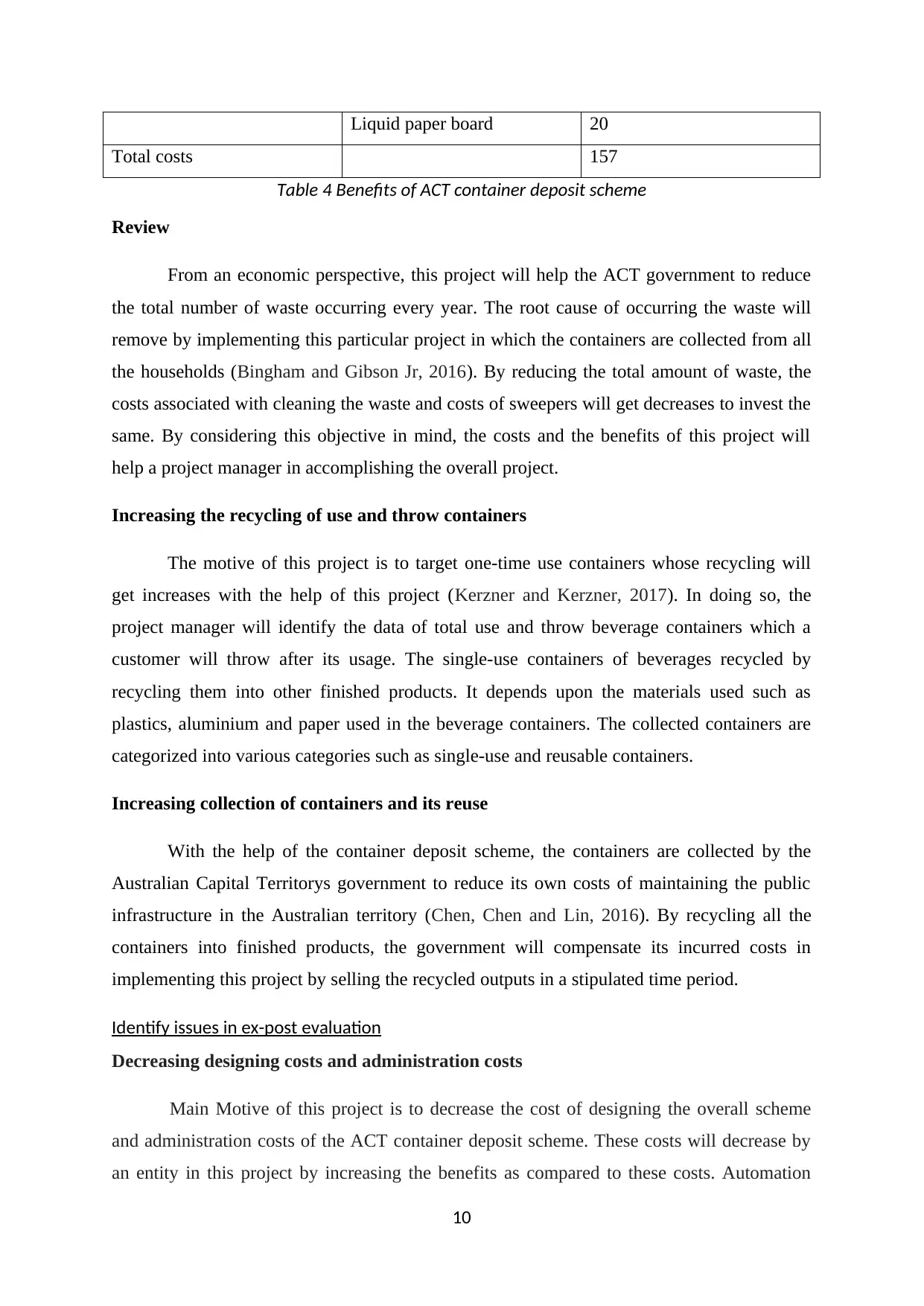
Liquid paper board 20
Total costs 157
Table 4 Benefits of ACT container deposit scheme
Review
From an economic perspective, this project will help the ACT government to reduce
the total number of waste occurring every year. The root cause of occurring the waste will
remove by implementing this particular project in which the containers are collected from all
the households (Bingham and Gibson Jr, 2016). By reducing the total amount of waste, the
costs associated with cleaning the waste and costs of sweepers will get decreases to invest the
same. By considering this objective in mind, the costs and the benefits of this project will
help a project manager in accomplishing the overall project.
Increasing the recycling of use and throw containers
The motive of this project is to target one-time use containers whose recycling will
get increases with the help of this project (Kerzner and Kerzner, 2017). In doing so, the
project manager will identify the data of total use and throw beverage containers which a
customer will throw after its usage. The single-use containers of beverages recycled by
recycling them into other finished products. It depends upon the materials used such as
plastics, aluminium and paper used in the beverage containers. The collected containers are
categorized into various categories such as single-use and reusable containers.
Increasing collection of containers and its reuse
With the help of the container deposit scheme, the containers are collected by the
Australian Capital Territorys government to reduce its own costs of maintaining the public
infrastructure in the Australian territory (Chen, Chen and Lin, 2016). By recycling all the
containers into finished products, the government will compensate its incurred costs in
implementing this project by selling the recycled outputs in a stipulated time period.
Identify issues in ex-post evaluation
Decreasing designing costs and administration costs
Main Motive of this project is to decrease the cost of designing the overall scheme
and administration costs of the ACT container deposit scheme. These costs will decrease by
an entity in this project by increasing the benefits as compared to these costs. Automation
10
Total costs 157
Table 4 Benefits of ACT container deposit scheme
Review
From an economic perspective, this project will help the ACT government to reduce
the total number of waste occurring every year. The root cause of occurring the waste will
remove by implementing this particular project in which the containers are collected from all
the households (Bingham and Gibson Jr, 2016). By reducing the total amount of waste, the
costs associated with cleaning the waste and costs of sweepers will get decreases to invest the
same. By considering this objective in mind, the costs and the benefits of this project will
help a project manager in accomplishing the overall project.
Increasing the recycling of use and throw containers
The motive of this project is to target one-time use containers whose recycling will
get increases with the help of this project (Kerzner and Kerzner, 2017). In doing so, the
project manager will identify the data of total use and throw beverage containers which a
customer will throw after its usage. The single-use containers of beverages recycled by
recycling them into other finished products. It depends upon the materials used such as
plastics, aluminium and paper used in the beverage containers. The collected containers are
categorized into various categories such as single-use and reusable containers.
Increasing collection of containers and its reuse
With the help of the container deposit scheme, the containers are collected by the
Australian Capital Territorys government to reduce its own costs of maintaining the public
infrastructure in the Australian territory (Chen, Chen and Lin, 2016). By recycling all the
containers into finished products, the government will compensate its incurred costs in
implementing this project by selling the recycled outputs in a stipulated time period.
Identify issues in ex-post evaluation
Decreasing designing costs and administration costs
Main Motive of this project is to decrease the cost of designing the overall scheme
and administration costs of the ACT container deposit scheme. These costs will decrease by
an entity in this project by increasing the benefits as compared to these costs. Automation
10
Paraphrase This Document
Need a fresh take? Get an instant paraphrase of this document with our AI Paraphraser
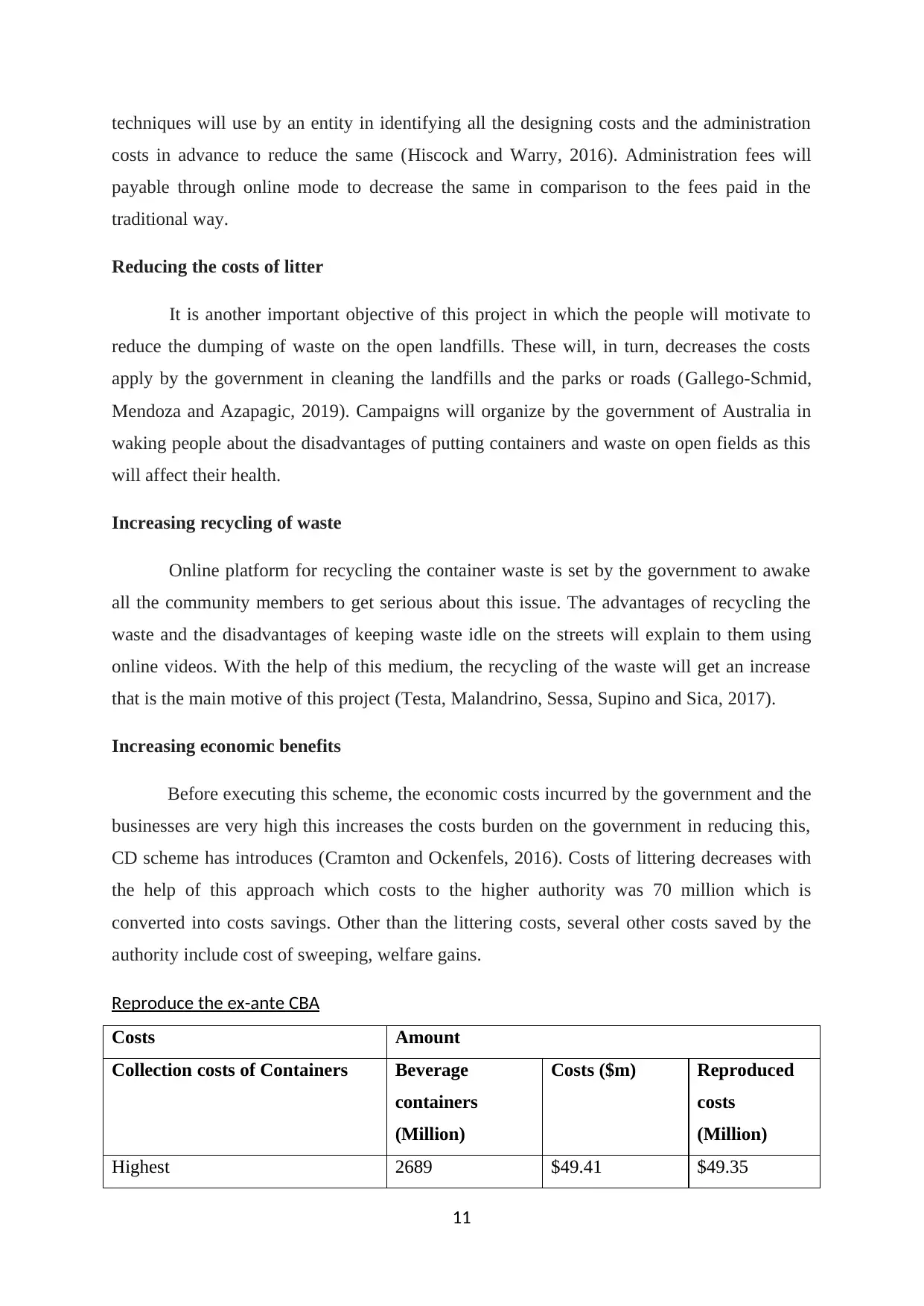
techniques will use by an entity in identifying all the designing costs and the administration
costs in advance to reduce the same (Hiscock and Warry, 2016). Administration fees will
payable through online mode to decrease the same in comparison to the fees paid in the
traditional way.
Reducing the costs of litter
It is another important objective of this project in which the people will motivate to
reduce the dumping of waste on the open landfills. These will, in turn, decreases the costs
apply by the government in cleaning the landfills and the parks or roads (Gallego-Schmid,
Mendoza and Azapagic, 2019). Campaigns will organize by the government of Australia in
waking people about the disadvantages of putting containers and waste on open fields as this
will affect their health.
Increasing recycling of waste
Online platform for recycling the container waste is set by the government to awake
all the community members to get serious about this issue. The advantages of recycling the
waste and the disadvantages of keeping waste idle on the streets will explain to them using
online videos. With the help of this medium, the recycling of the waste will get an increase
that is the main motive of this project (Testa, Malandrino, Sessa, Supino and Sica, 2017).
Increasing economic benefits
Before executing this scheme, the economic costs incurred by the government and the
businesses are very high this increases the costs burden on the government in reducing this,
CD scheme has introduces (Cramton and Ockenfels, 2016). Costs of littering decreases with
the help of this approach which costs to the higher authority was 70 million which is
converted into costs savings. Other than the littering costs, several other costs saved by the
authority include cost of sweeping, welfare gains.
Reproduce the ex-ante CBA
Costs Amount
Collection costs of Containers Beverage
containers
(Million)
Costs ($m) Reproduced
costs
(Million)
Highest 2689 $49.41 $49.35
11
costs in advance to reduce the same (Hiscock and Warry, 2016). Administration fees will
payable through online mode to decrease the same in comparison to the fees paid in the
traditional way.
Reducing the costs of litter
It is another important objective of this project in which the people will motivate to
reduce the dumping of waste on the open landfills. These will, in turn, decreases the costs
apply by the government in cleaning the landfills and the parks or roads (Gallego-Schmid,
Mendoza and Azapagic, 2019). Campaigns will organize by the government of Australia in
waking people about the disadvantages of putting containers and waste on open fields as this
will affect their health.
Increasing recycling of waste
Online platform for recycling the container waste is set by the government to awake
all the community members to get serious about this issue. The advantages of recycling the
waste and the disadvantages of keeping waste idle on the streets will explain to them using
online videos. With the help of this medium, the recycling of the waste will get an increase
that is the main motive of this project (Testa, Malandrino, Sessa, Supino and Sica, 2017).
Increasing economic benefits
Before executing this scheme, the economic costs incurred by the government and the
businesses are very high this increases the costs burden on the government in reducing this,
CD scheme has introduces (Cramton and Ockenfels, 2016). Costs of littering decreases with
the help of this approach which costs to the higher authority was 70 million which is
converted into costs savings. Other than the littering costs, several other costs saved by the
authority include cost of sweeping, welfare gains.
Reproduce the ex-ante CBA
Costs Amount
Collection costs of Containers Beverage
containers
(Million)
Costs ($m) Reproduced
costs
(Million)
Highest 2689 $49.41 $49.35
11
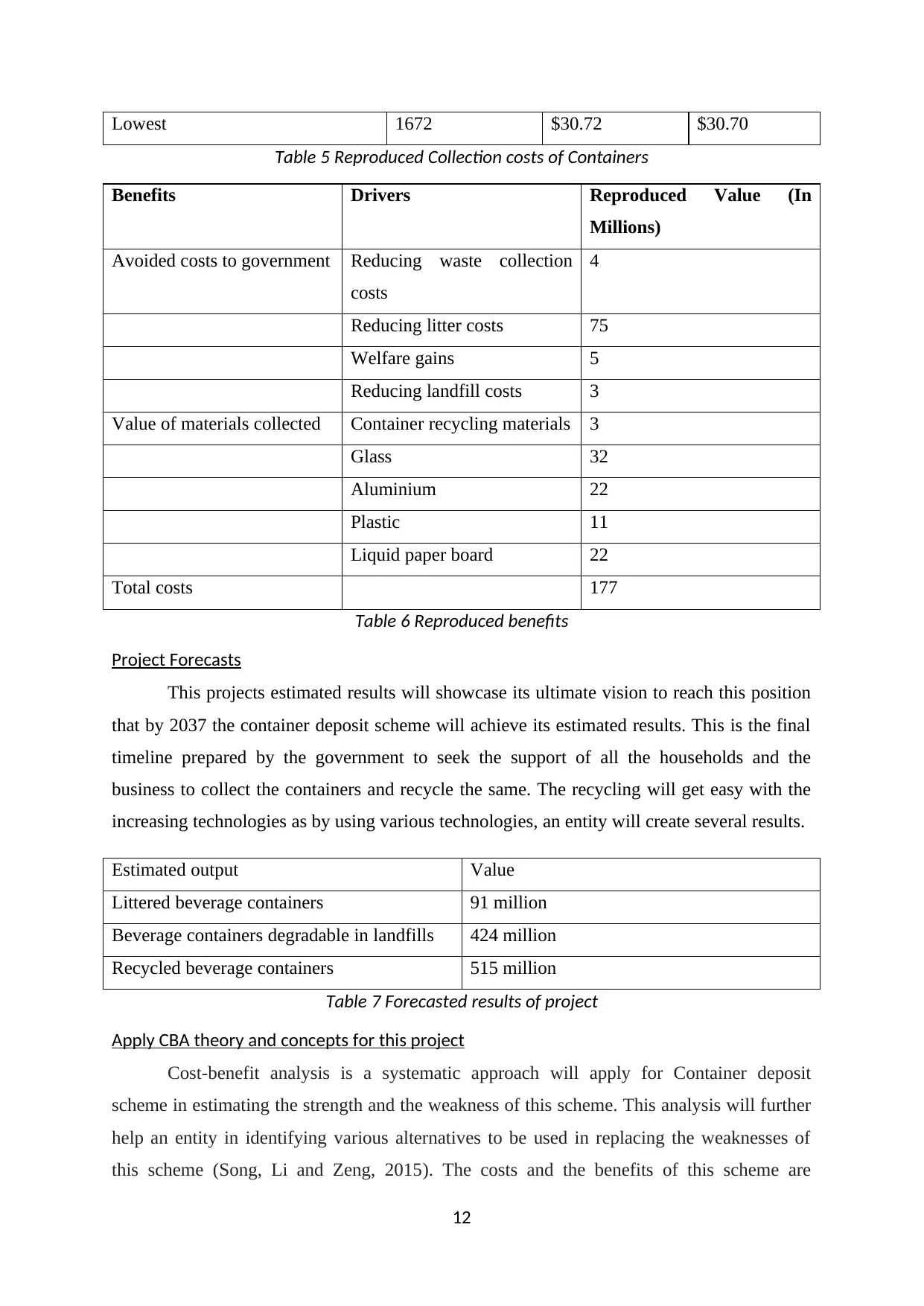
Lowest 1672 $30.72 $30.70
Table 5 Reproduced Collection costs of Containers
Benefits Drivers Reproduced Value (In
Millions)
Avoided costs to government Reducing waste collection
costs
4
Reducing litter costs 75
Welfare gains 5
Reducing landfill costs 3
Value of materials collected Container recycling materials 3
Glass 32
Aluminium 22
Plastic 11
Liquid paper board 22
Total costs 177
Table 6 Reproduced benefits
Project Forecasts
This projects estimated results will showcase its ultimate vision to reach this position
that by 2037 the container deposit scheme will achieve its estimated results. This is the final
timeline prepared by the government to seek the support of all the households and the
business to collect the containers and recycle the same. The recycling will get easy with the
increasing technologies as by using various technologies, an entity will create several results.
Estimated output Value
Littered beverage containers 91 million
Beverage containers degradable in landfills 424 million
Recycled beverage containers 515 million
Table 7 Forecasted results of project
Apply CBA theory and concepts for this project
Cost-benefit analysis is a systematic approach will apply for Container deposit
scheme in estimating the strength and the weakness of this scheme. This analysis will further
help an entity in identifying various alternatives to be used in replacing the weaknesses of
this scheme (Song, Li and Zeng, 2015). The costs and the benefits of this scheme are
12
Table 5 Reproduced Collection costs of Containers
Benefits Drivers Reproduced Value (In
Millions)
Avoided costs to government Reducing waste collection
costs
4
Reducing litter costs 75
Welfare gains 5
Reducing landfill costs 3
Value of materials collected Container recycling materials 3
Glass 32
Aluminium 22
Plastic 11
Liquid paper board 22
Total costs 177
Table 6 Reproduced benefits
Project Forecasts
This projects estimated results will showcase its ultimate vision to reach this position
that by 2037 the container deposit scheme will achieve its estimated results. This is the final
timeline prepared by the government to seek the support of all the households and the
business to collect the containers and recycle the same. The recycling will get easy with the
increasing technologies as by using various technologies, an entity will create several results.
Estimated output Value
Littered beverage containers 91 million
Beverage containers degradable in landfills 424 million
Recycled beverage containers 515 million
Table 7 Forecasted results of project
Apply CBA theory and concepts for this project
Cost-benefit analysis is a systematic approach will apply for Container deposit
scheme in estimating the strength and the weakness of this scheme. This analysis will further
help an entity in identifying various alternatives to be used in replacing the weaknesses of
this scheme (Song, Li and Zeng, 2015). The costs and the benefits of this scheme are
12
⊘ This is a preview!⊘
Do you want full access?
Subscribe today to unlock all pages.

Trusted by 1+ million students worldwide
1 out of 20
Your All-in-One AI-Powered Toolkit for Academic Success.
+13062052269
info@desklib.com
Available 24*7 on WhatsApp / Email
![[object Object]](/_next/static/media/star-bottom.7253800d.svg)
Unlock your academic potential
Copyright © 2020–2025 A2Z Services. All Rights Reserved. Developed and managed by ZUCOL.